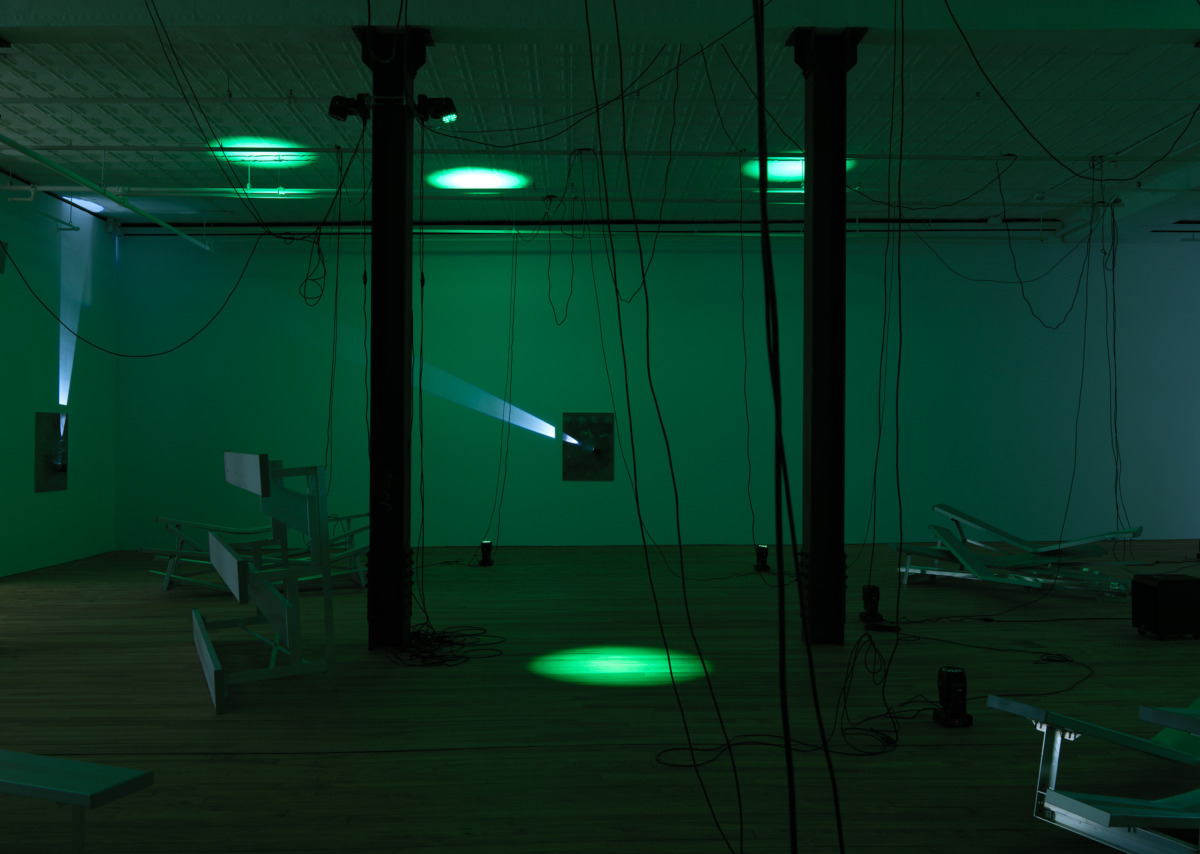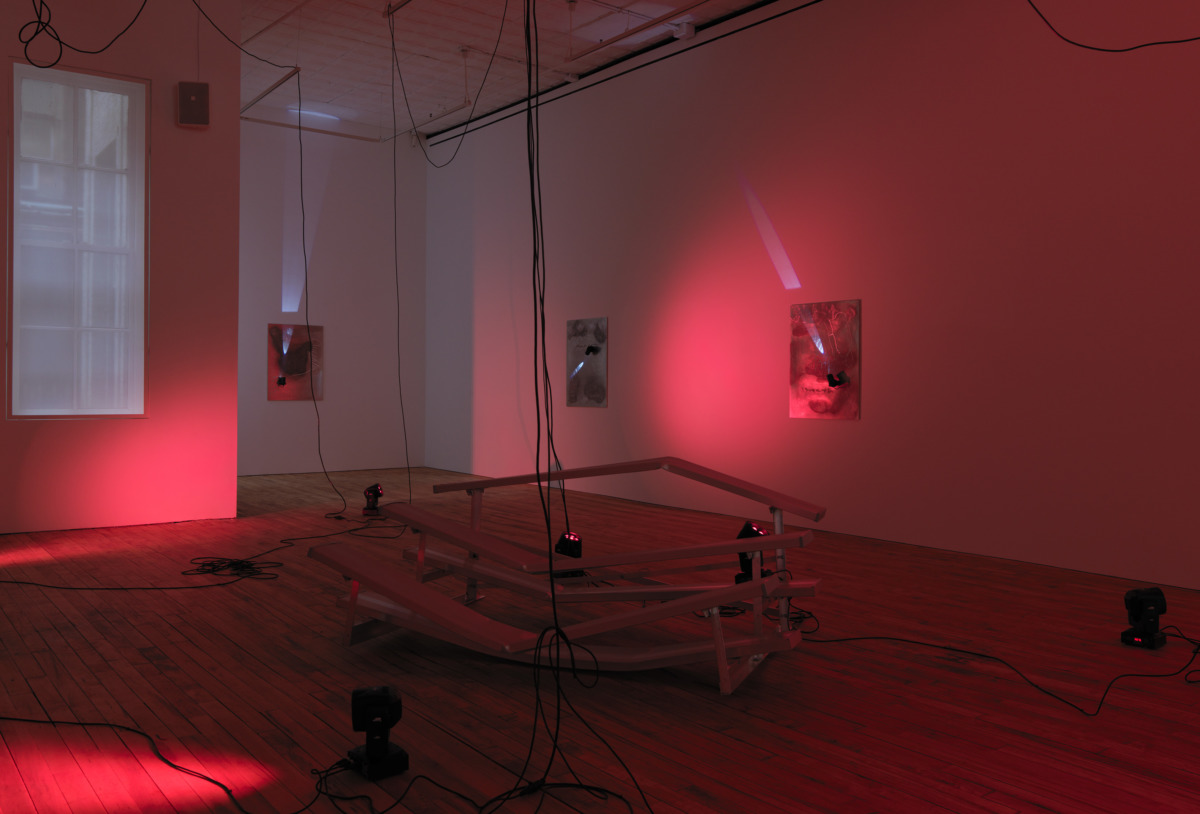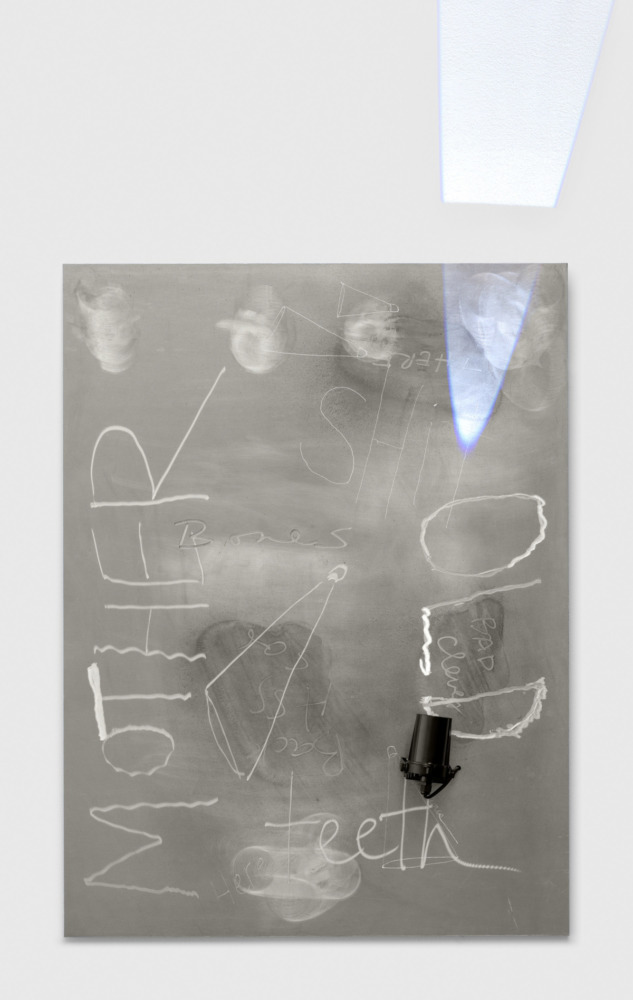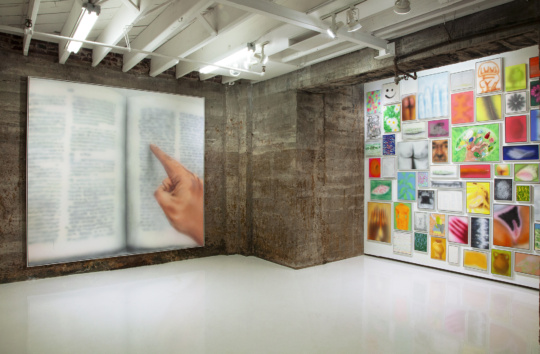
In February 2020, Nikita Gale set up the installation AUDIENCING in MoMA PS1’s outdoor dome. Part sculpture, part “performance without performers,” AUDIENCING was conceived as an immersive experience that called into question the nature of performing and witnessing through the theatrics of live music.[1] Instead of idly–and anonymously–watching the unfolding spectacle of lights and sound, the audience sat in the center of Gale’s stage apparatus, making them a part of the live experience for the forty-five minute duration of the experience. Now, two years later, Nikita Gale has returned to New York at David Zwirner’s new outpost 52 Walker to present END OF SUBJECT, a rigorous and thought-provoking piece that challenges traditional means of engaging with art, institutional spaces, and one’s physical presence.
The Los Angeles-based artist has long used sound and installation as a means of exploring the politics of power and the gaze, especially attending to the complexities added to this dynamic by race and gender. Growing up in a military family, Gale grew up around the United States including Atlanta, where the artist returned to work in Atlanta Contemporary’s Studio Artist program before decamping to California to pursue an MFA at the University of California, Los Angeles. The artist’s last solo exhibition was at the California African American Museum, where the Tina Turner-referencing installation PRIVATE DANCER, where the lights and positioning of objects was used to mimic human movement.

Similarly to Gale’s previous work, sound and movement are the starting point for questioning desire, visibility, and the politics of interpersonal relationships in the installation END OF SUBJECT (2022), which is contained in a single room in the Tribeca gallery. In the center of the room are six utilitarian aluminum benches. Instead of being used for seating, the benches are dented, folded, and smashed––rendered useless as places to sit and observe the unfolding scene. Accompanying the bleachers are spotlights; they rest on the bleachers, hang on the walls, and sit on the floor with their thick black wires dangling from the ceiling and unceremoniously strewn across the room. As the exhibition unfolds, these lights change color and illuminate different parts of the installation with an accompanying soundtrack by the Los Angeles-based musician Tashi Wada––a collaboration that Gale told me via email was “exciting and inspiring.”
In addition to the main centerpiece installation, a selection of six aluminum panels in the BODY PRINT series (all 2022) are hung on the wall. Gale interrupts the sleek surfaces of the metal with scratches, smears, and crudely etched works in a style that looks like post-apocalyptic graffiti. Gale’s selection of words and phrases all relate back to the physical body and its discontents: “brain,” “body,” “bones,” and “shit” all scrawled in different scripts. So present is the artist’s hand in these etchings that you can almost hear the unpleasant scraping marking the surface. Spotlights also flicker on the metal’s barely shiny surface, highlighting the marks and dents in the panel. Gale says that the “irregular” surfaces of the panels allows them to interact with the lighting component of the show as “the movement and behavior of the lights in the installation give the effect that the panels are animating—text images appear and disappear depending on the direction of the light.” The position of the viewer, too, alters the appearance of the BODY PRINT works, which Gale says “points to the instability of the human sense of vision.”

Together, the installation and panels create an experience that shifts the artist’s focus from the performer to the viewer, dismantling and renegotiating the dynamic between those who look and those who are looked upon. Gale tells me that in conceptualizing this project, the artist was “thinking through how the activities and ‘tasks’ of the human sensory system (namely listening and looking) can activate or deactivate structures that inform how subjects (such as people within institutions) are rendered or alienated/made invisible/made illegible.”
When I visited the exhibition on an unseasonably warm day in February, I was alone in the room, save one stylish couple who passed through the room and left within a few minutes of my arrival. Without the normal boundaries created by most exhibition spaces––the art is on the wall, floor markers control your proximity to three-dimensional works––I felt lost: I was nearly tripping over the wires and unsure of where to look next. In comparison to the tightly choreographed light show dancing in front of me, my body, uncontrolled and unfamiliar with its surroundings, felt out of place. This is, of course, exactly what I believe Gale intended. My gaze in institutions is normally unquestioned, but by placing my body inside of END OF SUBJECT, my presence was now negotiated. I could no longer access the work as a passive spectator, but instead had to experience the work on its own terms, letting the sensory experience of Gale’s work control me.

END OF SUBJECT’s various artistic components reflect this state of body-space negotiation. The smashed bleachers alert you to the fact that the normal audience-performer relationship has been destroyed, and the shifting spotlights draw your gaze away from a single focal point for your eye to comfortably focus on. Yet, the lights that flicker on the surface of the BODY PRINT panels serve as a reminder that although this experience is different, it is not uninviting or austere; as the lights shift, different words and phrases are highlighted before disappearing back into the metallic surface as the brightness shifts, allowing for a more multifaceted understanding of Gale’s process and innovative use of materials.
In our correspondence, Gale quotes the writings of bell hooks, specifically the writer’s 1992 essay collection Black Looks: Race and Representation. In the essay “The Oppositional Gaze: Black Female Spectators,” hooks writes “[in] resistance struggle, the power of the dominated to assert agency by claiming and cultivating ‘awareness’ politicizes ‘looking’ relations—one learns to look a certain way in order to resist.”[2] Nikita Gale’s END OF SUBJECT illustrates hooks’ idea of the reasserting agency in the gaze, creating the aesthetic conditions for an artistic and phenomenological experience that repositions the role of the audience. In the absence of the status quo, a new spatial understanding in END OF SUBJECT emerges. Yes, the normal dynamic has been abolished, but Gale’s art points us toward new ways to navigate the gaze that results in a more equitable and fulfilling means of engagement.
[1] Nikita Gale, “Subject Matters: Nikita Gale,” MoMA PS1, uploaded July 29, 2020.
[2] bell hooks, “The Oppositional Gaze: Black Female Spectators” in Black Look: Race and Representation (Boston: South End Press, 1992), 116.
Nikita Gale: END OF SUBJECT was on view at 52 Walker, New York, thru March 26.




